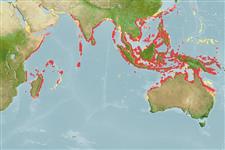Common names from other countries
>
Eupercaria/misc (Various families in series Eupercaria) >
Caesionidae (Fusiliers) > Caesioninae
Etymology: Pterocaesio: Greek, pteron = wing, fin + Latin, caesius = blue grey (Ref. 45335).
More on author: Cuvier.
Environment: milieu / climate zone / depth range / distribution range
Ecologia
marinhas associadas(os) a recifes; não migratória; intervalo de profundidade 2 - 25 m (Ref. 90102). Tropical; 30°N - 27°S, 40°E - 157°E (Ref. 402)
Indo-West Pacific: Red Sea and East Africa to eastern Australia.
Tamanho / Peso / Idade
Maturity: Lm ? range ? - ? cm
Max length : 21.0 cm TL macho/indeterminado; (Ref. 402)
Espinhos dorsais (total) : 10 - 11; Raios dorsais (total) : 14 - 16; Espinhos anais: 3; Raios anais : 11 - 13. Body light blue to brownish dorsally, white to pinkish ventrally. Broad yellow stripe just under lateral line (Ref. 48636). 4-5 cheek scales; 21-27 predorsal scales; scaled dorsal and anal fins. Upper peduncular scale rows usually 11 (11-13); lower peduncular scale rows usually 15 (14-17). Ventrolateral surface of basioccipital with a broad process for insertion of Baudelot's ligament. Post maxillary with 2 processes; posterior end of maxilla tapered. Small conical teeth in jaws, voter and palatines (Ref. 1723). Head length 3.0-3.5 in SL; body depth 3.3-4.6 in SL (Ref. 90102).
Ranges widely around coral reefs. Found in schools. Feeds on zooplankton in large midwater aggregations. Oviparous, with numerous, small pelagic eggs (Ref. 402). Also caught by drive-in nets. Valuable tuna baitfish.
Ciclo de vida ou comportamento de acasalamento
Maturities | Reprodução | Spawnings | Egg(s) | Fecundities | Larvas
Carpenter, K.E., 1987. Revision of the Indo-Pacific fish family Caesionidae (Lutjanoidea), with descriptions of five new species. Indo-Pac. Fish. (15):56 p. (Ref. 1723)
Status na Lista Vermelha da UICN (Ref. 130435)
CITES (Ref. 128078)
Not Evaluated
Ameaça para os humanos
Harmless
Uso pelos humanos
Pescarias: espécies comerciais; isca: usually
Ferramentas
Relatórios especiais
Baixar XML
Fontes da internet
Estimates based on models
Preferred temperature (Ref.
115969): 25.3 - 29.3, mean 28.6 (based on 2663 cells).
Índice de diversidade filogenética (Ref.
82804): PD
50 = 0.5002 [Uniqueness, from 0.5 = low to 2.0 = high].
Bayesian length-weight: a=0.01072 (0.00467 - 0.02458), b=3.12 (2.94 - 3.30), in cm Total Length, based on LWR estimates for this Genus-body shape (Ref.
93245).
Nível Trófico (Ref.
69278): 3.4 ±0.45 se; based on food items.
Resiliência (Ref.
120179): Elevada, tempo mínimo de duplicação da população menor que 15 meses (Preliminary K or Fecundity.).
Fishing Vulnerability (Ref.
59153): Low vulnerability (11 of 100).
